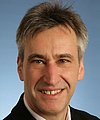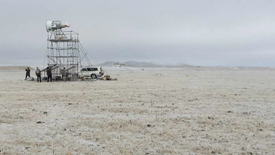24.11.2020 | logbook
Author ¶
An L-Band radiometer developed with contribution of the WSL has been standing on the Tibetan plateau for the past five years. What is it doing there, and what does that have to do with global satellite measurements of soil moisture? The physicist and electrical engineer Mike Schwank answers these questions in the WSL blog.
The renowned science journal Nature Scientific Data recently published interim results of a project [1] with which I am very closely connected as a WSL employee.
I remember very well the day when Prof. Bob Su from the University of Twente (Netherlands) called me in 2015. He wanted to use an L-band radiometer for a project in Tibet. In fact I had developed such an instrument together with the GAMMA REMOTE SENSING company (Gümligen BE) [2]. At that time the device was available for tests on the premises of the WSL. The employees jokingly used to call it “funnel” because of its peculiar appearance just like a funnel.
But what did Professor Su want to do with it on the Tibetan plateau?
The microwave emissions from soil, vegetation and snow indicate how much water they contain. This information is important to better understand the global water cycle and to improve the reliability of weather forecasts. To this end, the European Space Agency (ESA) is carrying out a long-term satellite mission called “Soil Moisture and Ocean Salinity” (SMOS). One of the goals of the SMOS mission is to measure the soil-water content on a global scale. In order to correctly interpret the data recorded by satellite, ground-based comparative measurements are an important aid. Thus, the ESA commissioned the international research group of Prof. Su [3] to carry out such measurements on the Tibetan plateau.
Made at WSL ¶
During the development work at GAMMA and at the WSL I established good contacts and occasional cooperation with the ESA. I was familiar with both the technical and the scientific side of the project that had just been launched, thus I was not surprised to get the research group’s request.
I quickly realized that the transport and commissioning of this large apparatus to Tibet would be a challenge. So I linked my collaboration to this condition: The professionals involved had to learn how to operate the “funnel” in Birmensdorf and they needed to know how to dismantle it by themselves for its transport all the way to Tibet.
In November 2015 we organized a radiometer workshop at the WSL. Together with Donghai Zheng and Prof. Yijian Zeng from the University of Twente, Dr. Jun Wen of the Chinese Academy of Sciences also joined us. For three days the three scientists immersed themselves in the basics of radiometry and learned how to handle the research device. On the last day, they then dismantled the “funnel” into its components for the airfreight transport.
The funnel's journey ¶
In the end, an adventurous truck journey was necessary from Chengdu airport to the field site in the Maqu district on the Tibetan plateau at 5000 m a.s.l. There the Tibetan scientists reassembled the device and successfully put it into operation.
Since then, the “funnel” has provided valuable ground-based measurements of thermal emissions (at 1.4 GHz) from the permafrost soil in the Yellow River catchment area. The microwave brightness temperatures measured with the "funnel" are compared with corresponding satellite retrievals (SMOS and SMAP) by ESA and NASA and are used, among other things, to validate their space-born observations.
I am currently working on the further development of L-band radiometers and their associated methods together with Derek Houtz and Reza Naderpour at the WSL. A “compact version” of the “funnel” has just returned from the MOSAiC expedition in the Arctic Ocean. A campaign similar to the one in Tibet is being planned for the winter 2020-21 in Sodankylä (Finland).
Video: Elbara-III Radiometer at the North Pole ¶
Publications ¶
Su Z., Wen J., Zeng Y., Zhao H., Lv S., van der Velde R., … Mecklenburg S. (2020) Multiyear in-situ L-band microwave radiometry of land surface processes on the Tibetan Plateau. Sci. Data. 7, 317 (13 pp.). https://doi.org/10.1038/s41597-020-00657-1Institutional Repository DORA
Schwank M., Wiesmann A., Werner C., Mätzler C., Weber D., Murk A., … Wegmüller U. (2010) ELBARA II, an L-band radiometer system for soil moisture research. Sensors. 10(1), 584-612. https://doi.org/10.3390/s100100584 Institutional Repository DORA
Links ¶
Prof. Bob Su's research group (University of Twente, Faculty of Geo-Information Science and Earth Observation)
Copyright ¶
WSL and SLF provide the artwork for imaging of press articles relating to this media release for free. Transferring and saving the images in image databases and saving of images by third parties is not allowed.





